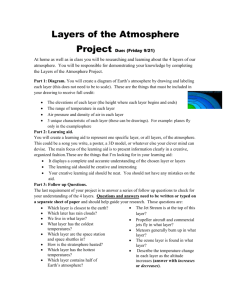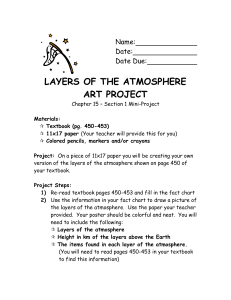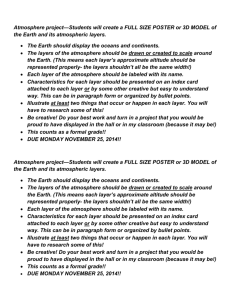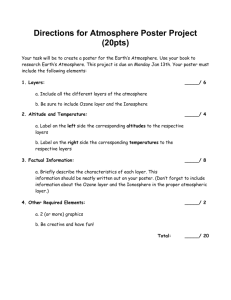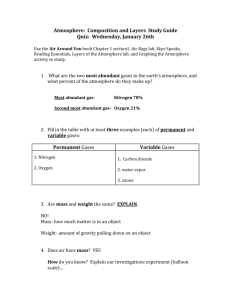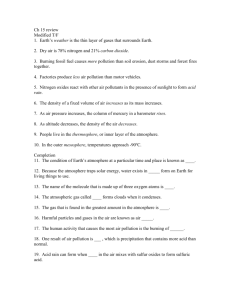E.FE.07.12 Win 09
advertisement
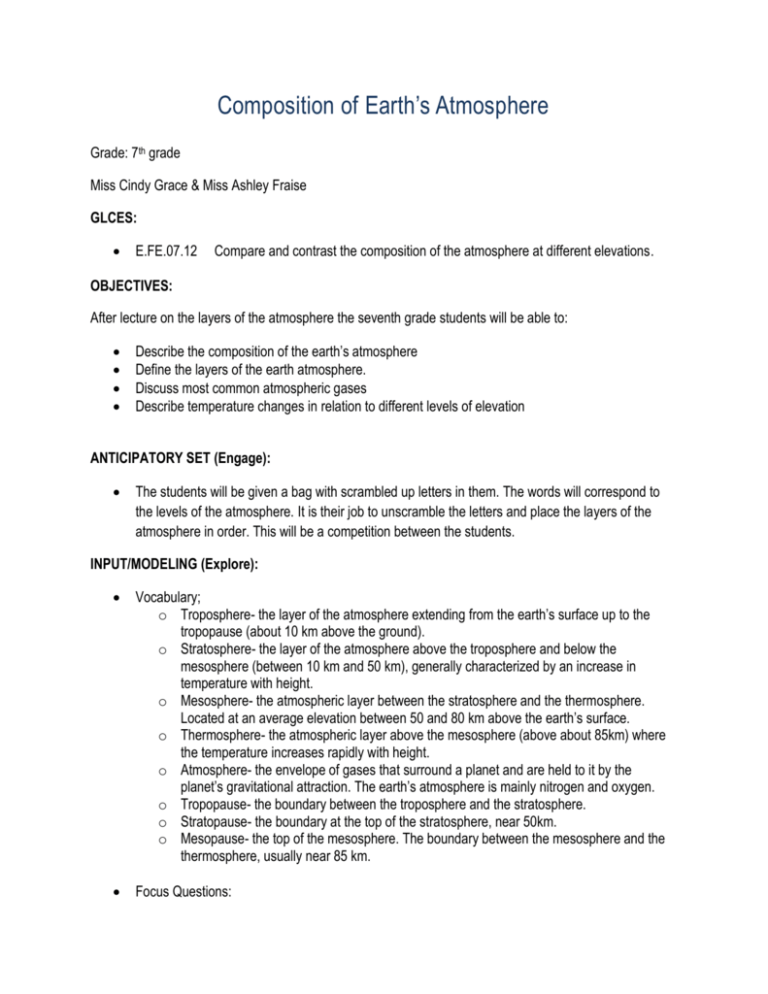
Composition of Earth’s Atmosphere Grade: 7th grade Miss Cindy Grace & Miss Ashley Fraise GLCES: E.FE.07.12 Compare and contrast the composition of the atmosphere at different elevations. OBJECTIVES: After lecture on the layers of the atmosphere the seventh grade students will be able to: Describe the composition of the earth’s atmosphere Define the layers of the earth atmosphere. Discuss most common atmospheric gases Describe temperature changes in relation to different levels of elevation ANTICIPATORY SET (Engage): The students will be given a bag with scrambled up letters in them. The words will correspond to the levels of the atmosphere. It is their job to unscramble the letters and place the layers of the atmosphere in order. This will be a competition between the students. INPUT/MODELING (Explore): Vocabulary; o Troposphere- the layer of the atmosphere extending from the earth’s surface up to the tropopause (about 10 km above the ground). o Stratosphere- the layer of the atmosphere above the troposphere and below the mesosphere (between 10 km and 50 km), generally characterized by an increase in temperature with height. o Mesosphere- the atmospheric layer between the stratosphere and the thermosphere. Located at an average elevation between 50 and 80 km above the earth’s surface. o Thermosphere- the atmospheric layer above the mesosphere (above about 85km) where the temperature increases rapidly with height. o Atmosphere- the envelope of gases that surround a planet and are held to it by the planet’s gravitational attraction. The earth’s atmosphere is mainly nitrogen and oxygen. o Tropopause- the boundary between the troposphere and the stratosphere. o Stratopause- the boundary at the top of the stratosphere, near 50km. o Mesopause- the top of the mesosphere. The boundary between the mesosphere and the thermosphere, usually near 85 km. Focus Questions: o What is the earth’s atmosphere composed of? o What are two main gases that make up the earth’s atmosphere? o How does temperature play a role in earth’s atmosphere? MATERIALS: Layers of the Atmosphere PowerPoint Lunchable® Pizza Layers of Earth’s Atmosphere worksheet Ziploc bags with cut-up letters (Unscramble project) Venn Diagram LESSON (Explain): The lesson will begin with the PowerPoint presentation. In the presentation the different layers of the atmosphere are describe and information is presented. Also in the presentation there are questions that the students must answer once the lecture portion is complete in order to make sure the students understand the material. (PowerPoint Outline is attached for reference) CHECKING FOR UNDERSTANDING: (Elaborate) Once the lecture portion is complete the students will complete a worksheet on the layers of the atmosphere. The worksheet includes the students drawing a picture of the atmosphere, defining the layers, graphing temperatures and matching facts about the atmosphere to the proper layer. (Evaluate) The students will complete a venn diagram comparing and contrasting the different layers of the atmosphere. Work Cited: Composition Atmosphere and Structure. 2008. Net Industries. Retrieved Jan 26, 2009 http://science.jrank.org/pages/590/Atmosphere-Composition-Structure.html Kovas, Thomas. “Chapter 1 Lecture Notes”. Winter 2009. http://reserves.emich.edu/eres/coursepage.aspx?cid=2518&page=docs# Littleton Public Schools.”Layers of the Atmosphere”. Retrieved Jan. 26, 2009. <http://arapahoe.littletonpublicschools.net/Portals/7/Science/1c%20Layers%20of%20Atm.pdf> Louviere, Georgia. “The Atmosphere”. The Center for Excellence an Equity in Education. 1997-2006. Retrieved Jan 26, 2009. <http://teachertech.rice.edu/Participants/louviere/atmos.html> PowerPoint Slides Earth’s Atmosphere • Earth’s Atmosphere – A thin, gaseous envelope comprised mostly of nitrogen and oxygen. – Extends upward for many hundreds of kilometers • • • Almost 99% is in 30 km of Earth’s surface Composition of the Atmosphere – N2, O2, and Ar make up 99.6% by volume of the dry atmosphere. – Water vapor makes up 0-4% of the atmosphere. – Other variable gases are also important: • H2O, CO2, CH4, N2O, and CFCs are greenhouse gases • O3 protects life from solar ultraviolet radiation and CFCs destroy O3 • Particles, O3, and others can affect health Layers of the Atmosphere The Atmosphere is divided into layers according to major changes in temperature. Gravity pushes the layers of air down on the earth's surface. This push is called air pressure. Temperature variations in these layers are due to the way the solar energy is absorbed as it moves downward through the atmosphere. • Layers of the Atmosphere • • Troposphere • 0 to 12 km - Contains 75% of the gases in the atmosphere. This is where you live and where weather occurs. As height increases, temperature decreases. The temperature drops about 6.5 degrees Celsius for every kilometer above the earth's surface. • Tropopause - located at the top of the troposphere. The temperature remains fairly constant here. This layer separates the troposphere from the stratosphere. We find the jet stream here. These are very strong winds that blow eastward. Stratosphere • • Mesosphere • • • • 12 to 50 km. The temperature remains fairly constant (-60 degrees Celsius). This layer contains the ozone layer. Ozone acts as a shield for the earth's surface. It absorbs ultraviolet radiation from the sun. This causes a temperature increase in the upper part of the layer. - 50 to 80 km. The temperature drops in this layer to about -100 degrees Celsius. This is the coldest region of the atmosphere. This layer protects the earth from meteoroids. They burn up in this area. Thermosphere • 80 km and up - The air is very thin. Thermosphere means "heat sphere". The temperature is very high in this layer because ultraviolet radiation is turned into heat. Temperatures often reach 2000 degrees Celsius or more. This layer contains: • Ionosphere - This is the lower part of the thermosphere. It extends from about 80 to 550 km. Gas particles absorb ultraviolet and X-ray radiation from the sun. The particles of gas become electrically charged (ions). Radio waves are bounced off the ions and reflect waves back to earth. This generally helps radio communication. However, solar flares can increase the number of ions and can interfere with the transmission of some radio waves. • Exosphere - the upper part of the thermosphere. It extends from about 550 km for thousands of kilometers. Air is very thin here. This is the area where satellites orbit the earth. Temperature and Layers of the Atmosphere • The pattern of temperature change in the vertical determines the different layers. • Temperature generally decreases as you go up except where ozone heats the layer known as the stratosphere and in the solar wind heats the layer known as the thermosphere. In Class Discussion Questions • What are the layers of the Earth’s atmosphere? • What are the two main gases in the atmosphere? • How does temperature play a role in Earth’s atmosphere? • What two layers does the temperature decrease? Increase? • What are the approximate heights of each layer? • In Class Activity • Complete the worksheet related to the layers of the atmosphere. • Using a Venn Diagram compare and contrast the different layers of the atmosphere.
